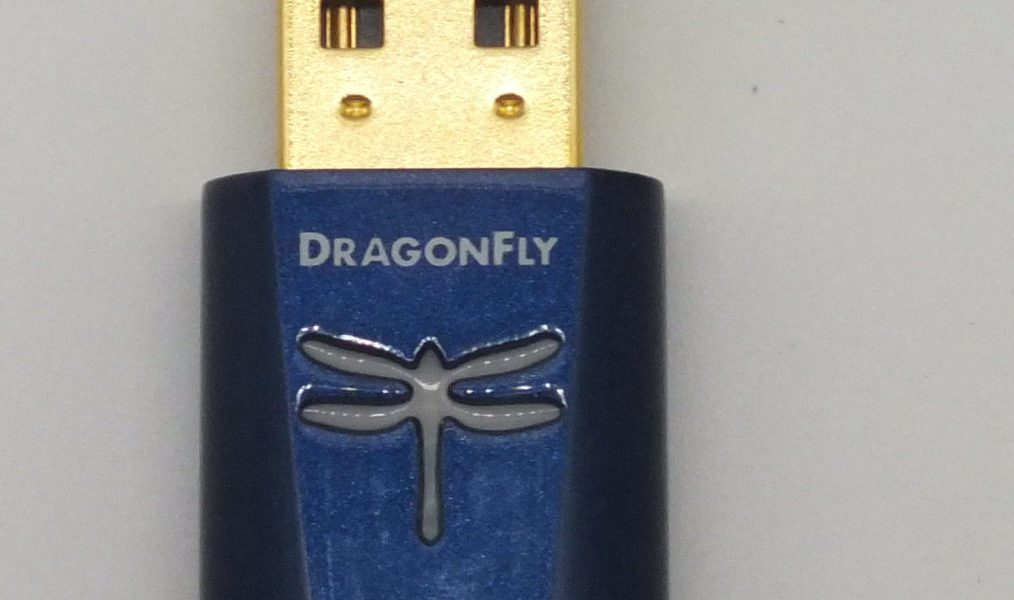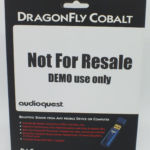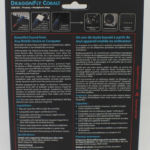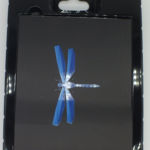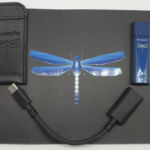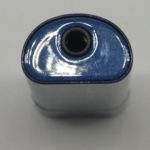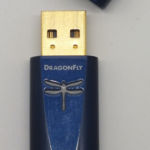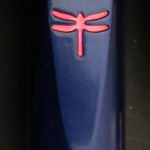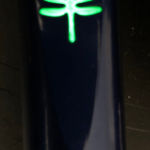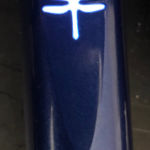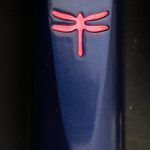AudioQuest Dragonfly Cobalt
I received the Cobalt as part of the TTVJ tour and kept it for a week to listen and then forwarded it on to the next tour participant. I have no financial interest in Audioquest or TTVJ and received no other incentives to compose this review. I’d like to thank Todd for providing me with the opportunity to listen to gear I might not have been able to otherwise. Todd the Vinyl Junkie carries a ton of cool stuff, so if you find yourself out shopping for things audio, have a look at his site.
Packaging:
The box the Cobalt came in had a large Sticker over most of the front but my understanding from others I have seen is the only thing covered by the sticker is a large dragonfly graphic. All the pertinent information is still visible in the photos below. Inside the box is a plastic tray with the manual on top and the case, dac, and USB-A to USB-C adapter. It is not what one would call upscale packaging or a large kit, but the case and cable are of good quality and give the impression they should last well, and the DAC itself (while tiny) appears well constructed.
Build/Internals:
Those who have had a chance to play with any model Dragonfly, will recognize the Cobalt immediately. It is about the size of a pack of Wrigley’s Spearmint with a large dragonfly that changes colors to indicate bit-rate of the file being played. The Cobalt is slightly narrower than either of its predecessors, but otherwise the same size and roughly the same weight. At one end is the USB-A port, while at the other a single 3.5mm TRS connector is fitted. A provided cable allows for connection to usb-C but is not an OTG cable so did not allow for direct connection to my Moto Z3.
The big draw for the cobalt is the improved DAC although power supply filtering improvements do contribute to improving the output from the amplifier section as well. The DAC used in the Cobalt is the ESS ES9038Q2M, a 2 channel mobile version of the 9038. For sake of reference, this is the same chip used in the Burson Swing and the Khadas Tone Board. This is not to be confused with the 9038pro as that chip is 8 channel or the ES9038K2M which includes a 2 Volt amp on the same silicone to minimize footprint for applications like tablets or phones. The ES9038Q2M offers several filters but the Cobalt is set to the minimum-phase slow roll-off by default which Audioquest claims gives the Cobalt a bit more natural sound than the previous generations that both utilized a fast roll-off filter instead.
By using the version that does not have internal amplification, Audioquest has the option of utilizing its own in-house design. That is exactly what Audioquest chose to do, and as such the amplifier section of the Cobalt is largely unchanged from the previous Dragonfly Red. Both utilize the ESS 9061 amplifier although as mentioned previously, the cobalt cleans up input power a bit better than the Red, and also uses a lower powered main processor (Pic32MX274 (Cobalt) vs Pcic32MX (Red)) that frees up more of the input power to be used to run the DAC and Amp sections of the Cobalt.
One detail worth noting is that some play exists between the USB and jack and the shell. I can physically rock the jack by placing an finger on it and watch the usb move so the board is all that supports the jack and USB. I am not sure if this is by design or the result of a tour unit that has taken more abuse than it should before it arrived (it does not look abused) so production models may have tighter tolerances.
Operation:
Operation is straight forward as the DAC was detected by Windows without having to install drivers or fuss with it. Once Setup as the output in Foobar, I was able to throw a variety of tracks at the Cobalt and watch the little dragonfly on top change colors as I went. MQA is lavender, other than that, the dragonfly identifies bit rate rather than file type with 44.1kHz being green, 48kHz blue, 88.2kHz yellow, and 96kHz a lighter blue color. The Cobalt has a 64 position volume control that gives it good range but for me it lacks a bit of volume on some full sized cans. I found it was best reserved for use as the DAC to an external amplifier in those situations.
When paired to an android phone, the dragonfly worked equally well with USB Audio Player Pro providing the source material. With the Camera connection kit, I was also able to get the Cobalt going on an Iphone 8 without any extra hassle. I did see a bit of battery drain associated with using the cobalt paired to mobile devices, but overall it was less than several other devices I have tried. (more on that in comparisons).
Sound:
I have never been a fan of the dragonfly models, and my complaint has always been that they lacked control and sounded a bit loose. I am happy to say that the Cobalt has gone a long way to correct this as bass is impactful without becoming boomy and treble is definitely tighter and more articulate than the Red. It is moves in the correct direction. Overall, I would describe the Cobalt as slightly laidback and musical but with reasonably good control and detail. Dynamics are better than the Red as well. Lower treble is slightly forward and may seem overly bright if your source material already leans that way or you are particularly sensitive. If there is a knock in the sound department, it is as the output demand goes up it begins to lose a bit of low end as it just cant provide the needed current to really drive hard to drive headphones. I would avoid things like 600Ω Beyers or the big inefficient planars like the He-560 as it isnt particularly successful with either of them. Best pairings are low impedance / High sensitivity earphones or headphones. At times I struggled to get the amount of volume I would have liked with some cans (Cascade/HD700).
Limits:
Sound of the cobalt is dependent on what is providing the source material. I found connecting to an android tablet would only show green (48kHz) regardless of what it was fed. Turns out this is a limit of android and when paired with UAPP it works correctly. The problem is in android and not the Cobalt. With the UAPP drivers, it handles input appropriately and the color changes when different bit rates are presented. I also found noise was slightly lower when I used the same content through the UAPP driver vs the built in android systems.
The 24/96 limit of the cobalt has nothing to do with the DAC, instead it has to do with universal support. The trade off comes from the fact that Audio type 1 (required for driverless operation) only supports up to 24/96. Had the Cobalt been configured as a USB-type 2 device it could have gone up to 32/384 (limit of the dac) but with the added hassle of specialty drivers being required to do so. Audioquest clearly chose ease of use over absolute fidelity.
Comparisons:
I tried to pick a few other daps that have something in common with the Cobalt so 3 of these are competitors in the portable world and the 4th is a desktop board that uses the same DAC chip albeit lacking the amplifier stage of the Cobalt.
Khadas Tone Board – The Tone board has been quite popular as it combines the ES9038Q2M DAC with a USB input and RCA outputs at a roughly $100 US Price point. In use, I find the Tone board to have good detail and a broad range of supported formats including DSD up to 256k and MQA as well as the standard Flac, Alac, mp3 etc. The tone board makes no attempt to amplify the signal for use as a headphone amp so cannot be used as a stand alone like the Cobalt can, but supports her resolution files 24/384 vs 24/96 and offers better DSD decoding. Ultimately, I think the tone board is a bit cleaner and tighter than the Cobalt but this may well be impacted by the amp attached to the tone board as well. If you have to have portable use, the Cobalt is a better option, if for desktop use feeding another amp, I’d opt for the KTB.
Zorloo ZuperDAC – in comparing the Zuperdac vs the Cobalt, we have two devices that both share the same form factor and same amplifier chip but two different generations of DAC. The Zuper uses the 9018 series chip for its DAC. Perhaps oddly the Cobalt is limited to 24/96 while the older device handles 24/192. The Cobalt fires back with MQA and DSD support which are absent on the Zuper. Sound is better controlled and a bit tighter on the Cobalt while the Zuper seems to lose a bit of control at both ends. This would be an easy win for the Cobalt except for that nagging lack of support for 24/192.
Apogee Groove – Here we have a dogfight. The Groove uses a full 8 channel version of the ESS series DAC and sums 4 channels to create its output. This lowers noise and THD and allows the Groove to post numbers not unlike the Cobalt even though it uses a much older chip. Apogee doesn’t disclose other than to say it uses and ESS with 4 channels summed. Best guess is the chip is either a 9008 or 9016s as those are the most cost effective possibilities. The groove supports 24/192 but not DSD or MQA so format support isnt going to separate the two unless you have to have DSD or MQA hardware unfolding. Upsides for the Groove are its micro-usb female connector that allows a broad range of cabling options for connections to PC or tablet and its built in volume control keys. Upsides for the Cobalt are its lower power draw and smaller form factor. Those using android or apple phones will prefer the Cobalt as while its output is not as potent as that of the Groove, it also doesn’t have the demand on the battery that makes the groove all but unusable from a phone.
Centrance DACPort-HD –This is another tough fight for the Cobalt. The Dacport is larger and uses a female port like the Groove, but has a form factor closer to that of the Cobalt. The Dacport-HD utilizes the AK4490 chip at its core and while it does not support MQA, it does support 32/384 flac and DSD64 and 128. The DACport-HD feels more solid than the Cobalt but is nearly double its size and weight so again those using it to pair with a portable device will find the Cobalt more convenient. Centrance does not market the DACport-HD for use with android or IOS devices and while I was able to get android to recognize it using USB Audio player pro, it drained the battery quite quickly. Power is no contest as the DACport can easily drive my 600Ω Beyerdynamics while the Cobalt begins to struggle considerably before reaching anywhere near 600Ω.
The Cobalt is certainly the best of the line and an improvement over previous generations in both sound and power, but still suffers from some of the same limits as its predecessors. Trade-offs made for ease of use and portability prevent the high-end chip used from accomplishing its full mission. For those where portability reigns king, the Cobalt will find an easy niche, for the rest of us, those same trade-offs may make it look less than attractive.
Audioquest Dragonfly Cobalt
Summary
Pros: very easy to use with no drivers needed and best sound yet from a dragonfly
Cons: trade-offs for ease of use limit resolution, build quality only fair

